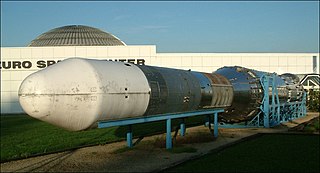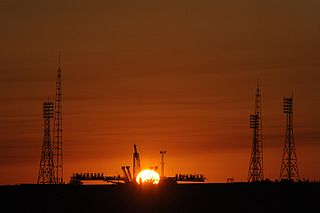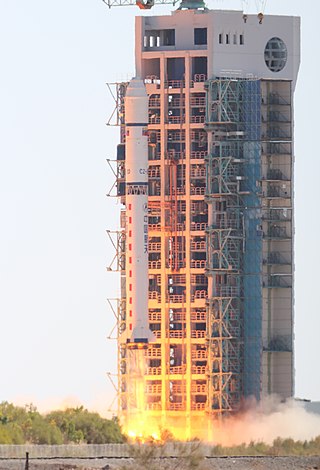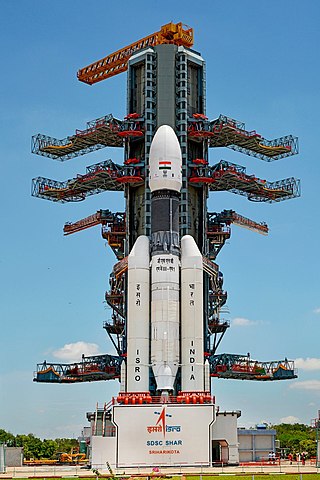
The de Havilland Propellers Blue Streak was a British Intermediate-range ballistic missile (IRBM), and later the first stage of the Europa satellite launch vehicle. Blue Streak was cancelled without entering full production.

The Europa rocket was an early expendable launch system of the European Launcher Development Organisation (ELDO), which was the precursor to the European Space Agency (ESA). It was developed with the aim to delivering space access technology, and more specifically to facilitate the deployment of European-wide telecommunication and meteorological satellites into orbit.

The Diamant rocket was the first exclusively French expendable launch system and at the same time the first satellite launcher not built by either the United States or USSR. As such, it has been referred to as being a key predecessor for all subsequent European launcher projects.

A spaceport or cosmodrome is a site for launching or receiving spacecraft, by analogy to a seaport for ships or an airport for aircraft. The word spaceport, and even more so cosmodrome, has traditionally been used for sites capable of launching spacecraft into orbit around Earth or on interplanetary trajectories. However, rocket launch sites for purely sub-orbital flights are sometimes called spaceports, as in recent years new and proposed sites for suborbital human flights have been frequently referred to or named "spaceports". Space stations and proposed future bases on the Moon are sometimes called spaceports, in particular if intended as a base for further journeys.

Cape Canaveral Space Force Station (CCSFS) is an installation of the United States Space Force's Space Launch Delta 45, located on Cape Canaveral in Brevard County, Florida.

Jiuquan Satellite Launch Center is a Chinese space vehicle launch facility (spaceport) located in the Gobi Desert, Inner Mongolia. It is part of the Dongfeng Aerospace City. Although the facility is geographically located within Ejin Banner of Inner Mongolia's Alxa League, it is named after the nearest city, Jiuquan in Gansu Province. The launch center straddles both sides of the Ruo Shui river.
Black Knight was a British research sounding rocket, originally developed to test and verify the design of a re-entry vehicle for the Blue Streak missile. It was the United Kingdom's first indigenous space launcher.

Black Arrow, officially capitalised BLACK ARROW, was a British satellite carrier rocket. Developed during the 1960s, it was used for four launches between 1969 and 1971, all launched from the Woomera Prohibited Area in Australia. Its final flight was the first and only successful orbital launch to be conducted by the United Kingdom, and placed the Prospero satellite into low Earth orbit.

The Prospero satellite, also known as the X-3, was launched by the United Kingdom in 1971. It was designed to undertake a series of experiments to study the effects of the space environment on communications satellites and remained operational until 1973, after which it was contacted annually for over 25 years. Although Prospero was the first British satellite to have been launched successfully by a British rocket, Black Arrow; the first British satellite placed in orbit was Ariel 1, launched in April 1962 on a US rocket.

Esrange Space Center is a rocket range and research centre located about 40 kilometers east of the town of Kiruna in northern Sweden. It is a base for scientific research with high-altitude balloons, investigation of the aurora borealis, sounding rocket launches, and satellite tracking, among other things. Located 200 km north of the Arctic Circle and surrounded by a vast wilderness, its geographic location is ideal for many of these purposes.

Woomera, unofficially Woomera village, refers to the domestic area of RAAF Base Woomera. Woomera village has always been a Defence-owned and operated facility. The village is located on the traditional lands of the Kokatha people in the Far North region of South Australia, but is on Commonwealth-owned land and within the area designated as the 'Woomera Prohibited Area' (WPA). The village is approximately 446 kilometres (277 mi) north of Adelaide. In common usage, "Woomera" refers to the wider RAAF Woomera Range Complex (WRC), a large Australian Defence Force aerospace and systems testing range covering an area of approximately 122,000 square kilometres (47,000 sq mi) and is operated by the Royal Australian Air Force.

The European Launcher Development Organisation (ELDO) is a former European space research organisation. It was first developed in order to establish a satellite launch vehicle for Europe. The three-stage rocket developed was named Europa, after the mythical Greek goddess. Overall, there were 10 launches that occurred under ELDO's funding. The organisation consisted of Belgium, Britain, France, Germany, Italy, and the Netherlands. Australia was an associate member of the organisation.

Skylark was a family of British sounding rockets. It was operational between 1957 and 2005.
The Australian Space Research Institute (ASRI) was formed 1991 with the merger of the AUSROC Launch Vehicle Development Group at Monash University, Melbourne and the Australian Space Engineering Research Association (ASERA).

Satish Dhawan Space Centre - SDSC is a rocket launch centre (spaceport) operated by Indian Space Research Organisation (ISRO). It is located in Sriharikota, Tirupati district of Andhra Pradesh. Sriharikota Range was renamed in 2002 after ISRO's former chairman Satish Dhawan.

This is a timeline of first orbital launches by country. While a number of countries have built satellites, as of 2022, eleven countries have had the capability to send objects into orbit using their own launch vehicles. Russia and Ukraine inherited the space launchers and satellites capability from the Soviet Union, following its dissolution in 1991. Russia launches its rockets from its own and foreign (Kazakh) spaceports.
The British space programme is the British government's work to develop British space capabilities. The objectives of the current civil programme are to "win sustainable economic growth, secure new scientific knowledge and provide benefits to all citizens."

The Armstrong Siddeley, later Bristol SiddeleyGamma was a family of rocket engines used in British rocketry, including the Black Knight and Black Arrow launch vehicles. They burned kerosene fuel and hydrogen peroxide. Their construction was based on a common combustion chamber design, used either singly or in clusters of up to eight.
Orba, also known as X-2, was intended to be the first satellite launched by a British rocket. It was launched at 00:34 GMT on 2 September 1970, atop a Black Arrow rocket from Launch Area 5B at Woomera, but failed to reach orbit after the second stage of the carrier rocket shut down 13 seconds early. Orba was built from spare parts due to funding restrictions, and was to have been used to measure upper atmosphere density by monitoring the decay of its orbit.

The RAAF Woomera Range Complex (WRC) is a major Australian military and civil aerospace facility and operation located in South Australia, approximately 450 km (280 mi) north-west of Adelaide. The WRC is operated by the Royal Australian Air Force (RAAF), a division of the Australian Defence Force (ADF). The complex has a land area of 122,188 km2 (47,177 sq mi) or roughly the size of North Korea or Pennsylvania. The airspace above the area is restricted and controlled by the RAAF for safety and security. The WRC is a highly specialised ADF test and evaluation capability operated by the RAAF for the purposes of testing defence materiel.















